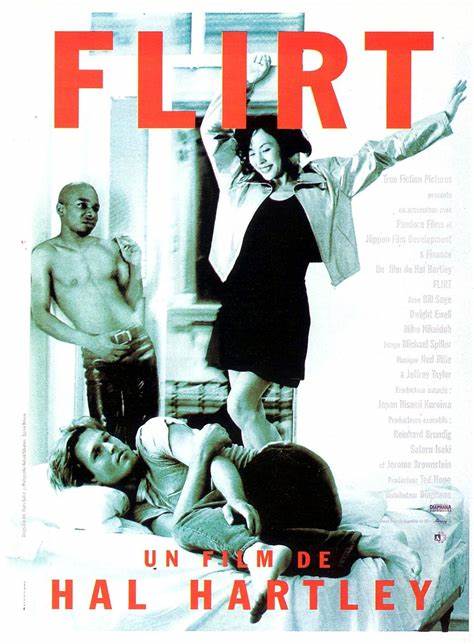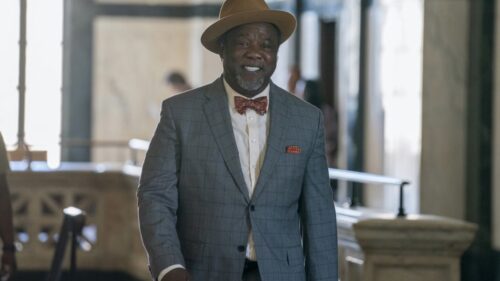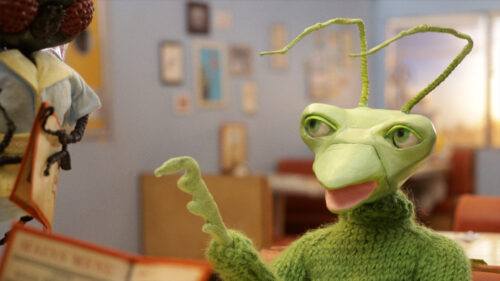I should like Hal Hartley‘s “Flirt” a lot more than I do, since it illustrates one of my favorite mantras: “A film is not about what it is about, but how it is about it.” A good film or a bad film can be made about anything. Therefore, to dismiss (or praise) a film solely because of its subject matter, it is not necessary to see it. That is why people who make statements beginning with the words “I don’t like films about…” are idiots, or censors.
What “Flirt” does is tell the same story three different times, in three different countries, in three slightly different ways. Thus it proves my point. All three stories are “about” the same thing–a flirtatious lover trying to decide between two enticing partners. By telling the story three times, Hartley invites us to see the story as simply the occasion for the exercise of his art. Which of the versions, we can ask, tells the story best? The “New York” section of the film involves a man who ends up explaining, “I was shot by the husband of a woman I thought I might be in love with.” The “Berlin” section involves a gay man who explains, “I was shot by the wife of a man I thought I might be in love with.” In “Tokyo,” the milieu changes to the intrigues in a dance troupe, but the dynamic is essentially the same.
In each story, a character is about to leave town and asks a new lover: “Do we have a future together?” In each story, the new lover asks for time, and calls another lover, trying to decide between the two. In each story, three bystanders give advice. In each story, there is a telephone conversation involving much use of the word “no,” and a shooting, and a scene in an emergency room.
As an idea, I like it. It would be useful in a film class. I will refer to it in other reviews. It illustrates a point, and an approach. It took nerve to make. Hartley keeps pushing the edges of the envelope. But it’s not much fun to watch.
Sitting in the theater, I found myself musing about the theory of “memes” floated by Richard Dawkins, in his famous book “The Selfish Gene.” Memes are like genes, except they are composed of information, not DNA. He suggests that just as genes can contain the recipes for producing people, or cauliflowers, so memes contain information that can be combined to produce culture.
I have greatly oversimplified, of course, but the point is: Does “Flirt” make a Darwinian argument? Is it showing us three competing meme-groups, all beginning in much the same place on an evolutionary tree, just as in Mendel’s garden there might be three pea-patches? Are they in a struggle for survival of the fittest? The memes involved are all familiar to consumers of popular culture. They include (a) a love triangle, (b) the jealous partner, (c) a journey of separation, (d) a shooting, (e) the emergency room and (f) the answer to the question, “What happened to you?” (Of course, each meme is made up of countless tinier memes, like “drink,” “wound,” “makeup,” etc.) These memes can express themselves in different guises (English, German, Japanese, gay, straight). To a moviegoer from Mars who had never seen human beings before and knew nothing of our sexuality, they might look to be the same story. The Martian would not notice that one of the men in Berlin is black, and almost everyone in Tokyo is Japanese; to a Martian these differences would be just as invisible as three slightly different frogs might be to us. In the very long run, however, the fittest frog is likely to find its descendants still in the pond. And is one of these similar stories more likely to survive, and be told more often and inspire more other stories, than the others? I will not keep you in suspense: I do not know. But I suppose questions something like this are what Hal Hartley wants us to ask. I do not, in other words, think he expects us to say, “What a fascinating story! I want to see it told twice again–once in Berlin, once in Tokyo!” He has created a cultural experiment, an exercise in storytelling and movie going. Like many other cultural experiments (minimalist art, “Finnegan's Wake,” the Chicago Tribune’s new Friday section), it is more amusing to talk about than to experience. I’m going to dine out on “Flirt” for a long time. I won’t need to see it again; I’ll remember.



















